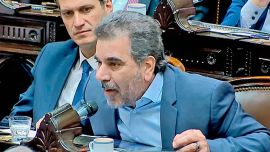Argentina’s Central Bank changed its benchmark tool for monetary policy Monday, replacing four-week notes with one-day transactions in a bid to lower borrowing costs.
The monetary authority will no longer auction its 28-day Leliq notes, which until now were used to determine its policy rate. Instead, the one-day repo notes that currently pay an interest rate of 100 percent will serve as the bank’s new policy benchmark.
Monday’s move aims to free up pesos for Argentine banks and strengthen demand for Treasury notes. Shortly after the Central Bank issued its statement, the government announced details of a peso debt auction Wednesday, with maturities of up to three years.
“The Argentine Central Bank’s adoption of the one-day repo rate as its main policy lever is more than just an operational adjustment. It shows the BCRA is confident that the government’s initial shock therapy — a fiscal adjustment and currency devaluation — will prevent a rush to US dollars or fan inflation further. We think confidence is a bit premature," said Adriana Dupita, Brazil and Argentina economist for Bloomberg Economics.
Argentina’s banks had been fleeing Leliqs before President Javier Milei took office December 10, rolling over the lowest amount of the notes on record in the weeks before and right after his inauguration. But after several policy moves last week, bank demand for Leliqs surged again.
Milei had warned that if banks continued to flee Leliqs, it could risk releasing more pesos into the economy and boost inflation that’s already at 160 percent year over year.
The Central Bank’s policy tool pivot runs contrary to a key pillar of Argentina’s US$44-billion agreement with the International Monetary Fund, which calls for monetary policy rates to exceed annual inflation. Even compounding for inflation, the new rate barely surpasses November’s annual consumer price figure. Economists see inflation ending this year above 200 percent, which would put the rate deep into negative territory if left unchanged.
related news
by Kevin Simauchi & Ignacio Olivera Doll, Bloomberg




















Comments